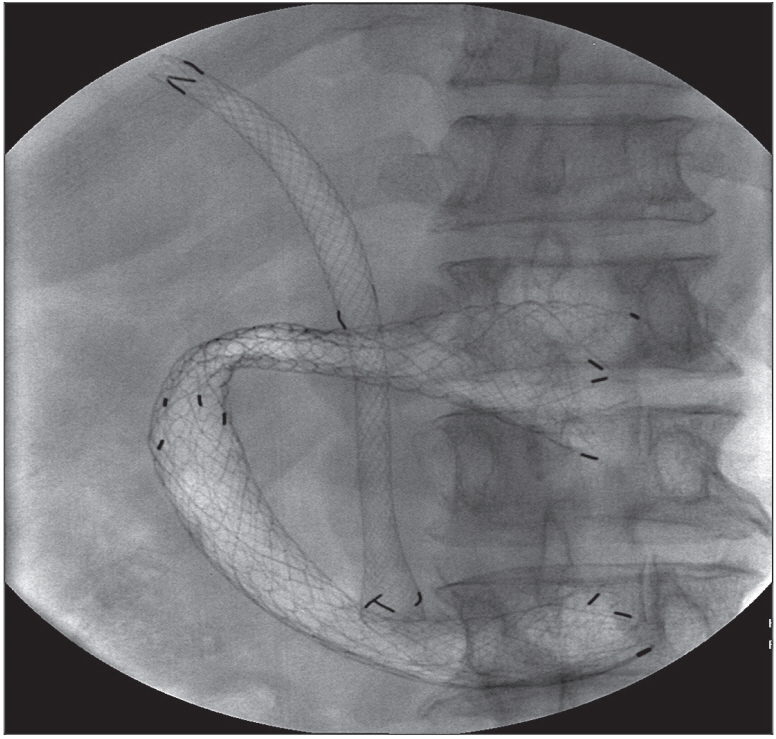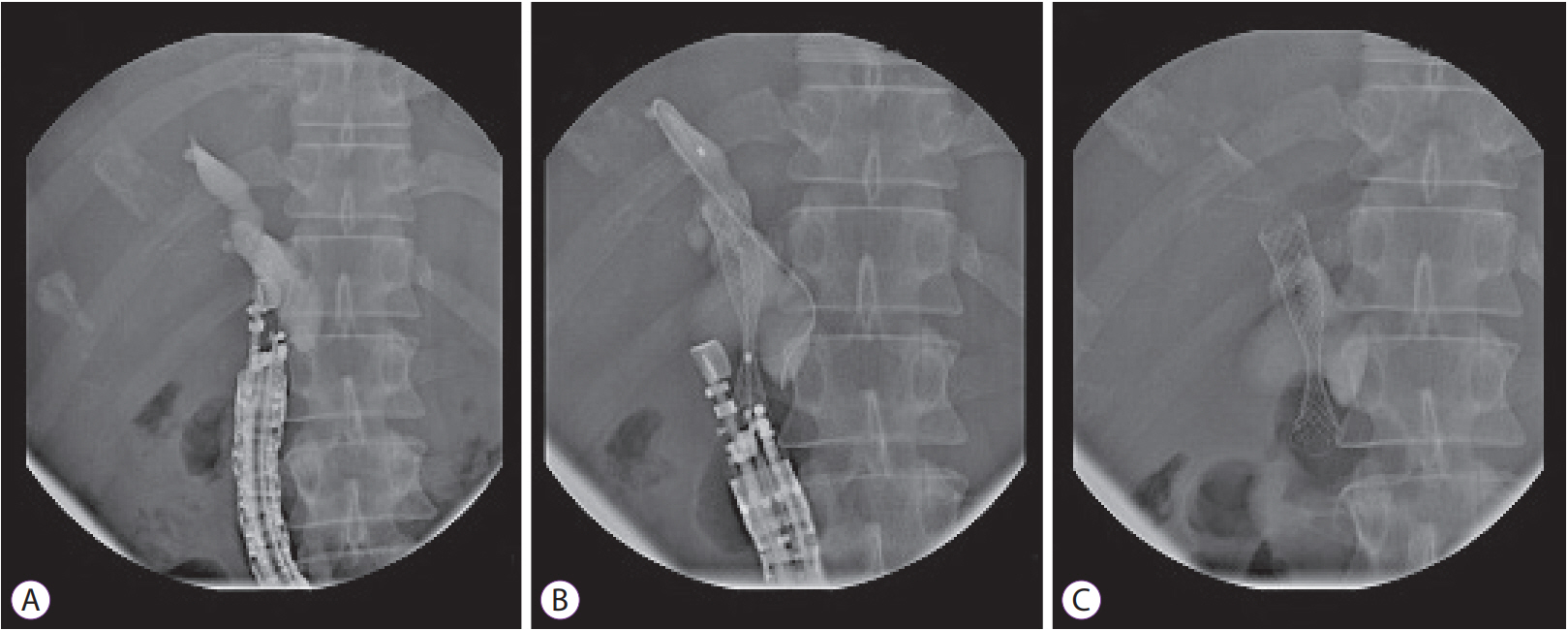Clin Endosc.
2019 Jan;52(1):40-46. 10.5946/ce.2018.102.
Endoscopic Management of Combined Biliary and Duodenal Obstruction
- Affiliations
-
- 1Department of Gastroenterology, Asian Institute of Gastroenterology, Hyderabad, India. zaheernabi1978@gmail.com
- KMID: 2438143
- DOI: http://doi.org/10.5946/ce.2018.102
Abstract
- Combined obstruction of the bile duct and duodenum is a common occurrence in periampullary malignancies. The obstruction of gastric outlet or duodenum can follow, occur simultaneously, or precede biliary obstruction. The prognosis in patients with combined obstruction is particularly poor. Therefore, minimally invasive palliation is preferred in these patients to avoid morbidity associated with surgery. Endoscopic palliation is preferred to surgical bypass due to similar efficacy, less morbidity, and shorter hospital stay. The success of endoscopic palliation depends on the type of bilioduodenal stenosis and the presence of previously placed duodenal metal stents. Biliary cannulation is difficult in type II bilioduodenal strictures where the duodenal stenosis is located at the level of the papilla. Consequentially, technical and clinical success is lower in these patients than in those with type I and III bilioduodenal strictures. However, in cases with failure of endoscopic retrograde cholangiopancreatography, with the introduction of endoscopic ultrasound for biliary drainage, the success of endoscopic bilioduodenal bypass is likely to increase further. The safety and efficacy of endoscopic ultrasound-guided drainage has been documented in multiple studies. With the development of dedicated accessories and standardization of drainage techniques, the role of endoscopic ultrasound is likely to expand further in cases with double obstruction.
MeSH Terms
Figure
Reference
-
1. Van Heek NT, De Castro SM, van Eijck CH, et al. The need for a prophylactic gastrojejunostomy for unresectable periampullary cancer: a prospective randomized multicenter trial with special focus on assessment of quality of life. Ann Surg. 2003; 238:894–902. discussion 902-905.2. Hamada T, Nakai Y, Lau JY, et al. International study of endoscopic management of distal malignant biliary obstruction combined with duodenal obstruction. Scand J Gastroenterol. 2018; 53:46–55.
Article3. Mutignani M, Tringali A, Shah SG, et al. Combined endoscopic stent insertion in malignant biliary and duodenal obstruction. Endoscopy. 2007; 39:440–447.4. Hosono S, Ohtani H, Arimoto Y, Kanamiya Y. Endoscopic stenting versus surgical gastroenterostomy for palliation of malignant gastroduodenal obstruction: a meta-analysis. J Gastroenterol. 2007; 42:283–290.
Article5. Rudolph HU, Post S, Schlüter M, Seitz U, Soehendra N, Kähler G. Malignant gastroduodenal obstruction: retrospective comparison of endoscopic and surgical palliative therapy. Scand J Gastroenterol. 2011; 46:583–590.
Article6. Zheng B, Wang X, Ma B, Tian J, Jiang L, Yang K. Endoscopic stenting versus gastrojejunostomy for palliation of malignant gastric outlet obstruction. Dig Endosc. 2012; 24:71–78.
Article7. Johnsson E, Thune A, Liedman B. Palliation of malignant gastroduodenal obstruction with open surgical bypass or endoscopic stenting: clinical outcome and health economic evaluation. World J Surg. 2004; 28:812–817.
Article8. Siddiqui A, Spechler SJ, Huerta S. Surgical bypass versus endoscopic stenting for malignant gastroduodenal obstruction: a decision analysis. Dig Dis Sci. 2007; 52:276–281.
Article9. Inamdar S, Slattery E, Bhalla R, Sejpal DV, Trindade AJ. Comparison of adverse events for endoscopic vs percutaneous biliary drainage in the treatment of malignant biliary tract obstruction in an inpatient national cohort. JAMA Oncol. 2016; 2:112–117.
Article10. Staub J, Siddiqui A, Taylor LJ, Loren D, Kowalski T, Adler DG. ERCP performed through previously placed duodenal stents: a multicenter retrospective study of outcomes and adverse events. Gastrointest Endosc. 2018; 87:1499–1504.11. Yao JF, Zhang L, Wu H. Analysis of high risk factors for endoscopic retrograde cholangiopancreatography biliary metallic stenting after malignant duodenal stricture SEMS implantation. J Biol Regul Homeost Agents. 2016; 30:743–748.12. Katsinelos P, Kountouras J, Germanidis G, et al. Sequential or simultaneous placement of self-expandable metallic stents for palliation of malignant biliary and duodenal obstruction due to unresectable pancreatic head carcinoma. Surg Laparosc Endosc Percutan Tech. 2010; 20:410–415.
Article13. Kaw M, Singh S, Gagneja H. Clinical outcome of simultaneous self-expandable metal stents for palliation of malignant biliary and duodenal obstruction. Surg Endosc. 2003; 17:457–461.
Article14. Maire F, Hammel P, Ponsot P, et al. Long-term outcome of biliary and duodenal stents in palliative treatment of patients with unresectable adenocarcinoma of the head of pancreas. Am J Gastroenterol. 2006; 101:735–742.
Article15. Kikuyama M, Itoi T, Sasada Y, Sofuni A, Ota Y, Itokawa F. Large-balloon technique for one-step endoscopic biliary stenting in patients with an inaccessible major papilla owing to difficult duodenal stricture (with video). Gastrointest Endosc. 2009; 70:568–572.
Article16. Donatelli G, Cereatti F, Dumont JL, et al. Temporary duodenal stenting as a bridge to ERCP for inaccessible papilla due to duodenal obstruction: a retrospective study. Endosc Int Open. 2016; 4:E957–E963.
Article17. Goutorbe F, Rouquette O, Mulliez A, et al. Temporary placement of a covered duodenal stent can avoid riskier anterograde biliary drainage when ERCP for obstructive jaundice fails due to duodenal invasion. Surg Endosc. 2017; 31:625–631.
Article18. Topazian M, Baron TH. Endoscopic fenestration of duodenal stents using argon plasma to facilitate ERCP. Gastrointest Endosc. 2009; 69:166–169.
Article19. Moon JH, Choi HJ, Ko BM, et al. Combined endoscopic stent-instent placement for malignant biliary and duodenal obstruction by using a new duodenal metal stent (with videos). Gastrointest Endosc. 2009; 70:772–777.
Article20. Tyberg A, Kumta N, Karia K, Zerbo S, Sharaiha RZ, Kahaleh M. EUS-guided gastrojejunostomy after failed enteral stenting. Gastrointest Endosc. 2015; 81:1011–1012.
Article21. Lee TH, Choi JH, Park do H, et al. Similar efficacies of endoscopic ultrasound-guided transmural and percutaneous drainage for malignant distal biliary obstruction. Clin Gastroenterol Hepatol. 2016; 14:1011–1019.e3.
Article22. Sharaiha RZ, Khan MA, Kamal F, et al. Efficacy and safety of EUS-guided biliary drainage in comparison with percutaneous biliary drainage when ERCP fails: a systematic review and meta-analysis. Gastrointest Endosc. 2017; 85:904–914.
Article23. Tonozuka R, Itoi T, Sofuni A, Itokawa F, Moriyasu F. Endoscopic double stenting for the treatment of malignant biliary and duodenal obstruction due to pancreatic cancer. Dig Endosc. 2013; 25 Suppl 2:100–108.
Article24. Canena J, Coimbra J, Carvalho D, et al. Endoscopic bilio-duodenal bypass: outcomes of primary and revision efficacy of combined metallic stents in malignant duodenal and biliary obstructions. Dig Dis Sci. 2014; 59:2779–2789.
Article25. Khashab MA, Valeshabad AK, Leung W, et al. Multicenter experience with performance of ERCP in patients with an indwelling duodenal stent. Endoscopy. 2014; 46:252–255.
Article26. Khashab MA, Fujii LL, Baron TH, et al. EUS-guided biliary drainage for patients with malignant biliary obstruction with an indwelling duodenal stent (with videos). Gastrointest Endosc. 2012; 76:209–213.
Article27. Wang K, Zhu J, Xing L, Wang Y, Jin Z, Li Z. Assessment of efficacy and safety of EUS-guided biliary drainage: a systematic review. Gastrointest Endosc. 2016; 83:1218–1227.28. Hamada T, Isayama H, Nakai Y, et al. Transmural biliary drainage can be an alternative to transpapillary drainage in patients with an indwelling duodenal stent. Dig Dis Sci. 2014; 59:1931–1938.
Article29. Yamao K, Kitano M, Takenaka M, et al. Outcomes of endoscopic biliary drainage in pancreatic cancer patients with an indwelling gastroduodenal stent: a multicenter cohort study in West Japan. Gastrointest Endosc. 2018; 88:66–75.e2.
Article30. Ogura T, Chiba Y, Masuda D, et al. Comparison of the clinical impact of endoscopic ultrasound-guided choledochoduodenostomy and hepaticogastrostomy for bile duct obstruction with duodenal obstruction. Endoscopy. 2016; 48:156–163.
Article31. Park JK, Woo YS, Noh DH, et al. Efficacy of EUS-guided and ERCP-guided biliary drainage for malignant biliary obstruction: prospective randomized controlled study. Gastrointest Endosc. 2018; 88:277–282.
Article32. Bang JY, Navaneethan U, Hasan M, Hawes R, Varadarajulu S. Stent placement by EUS or ERCP for primary biliary decompression in pancreatic cancer: a randomized trial (with videos). Gastrointest Endosc. 2018; 88:9–17.33. Chen YI, Itoi T, Baron TH, et al. EUS-guided gastroenterostomy is comparable to enteral stenting with fewer re-interventions in malignant gastric outlet obstruction. Surg Endosc. 2017; 31:2946–2952.
Article34. Perez-Miranda M, Tyberg A, Poletto D, et al. EUS-guided gastrojejunostomy versus laparoscopic gastrojejunostomy: an international collaborative study. J Clin Gastroenterol. 2017; 51:896–899.35. Khashab MA, Bukhari M, Baron TH, et al. International multicenter comparative trial of endoscopic ultrasonography-guided gastroenterostomy versus surgical gastrojejunostomy for the treatment of malignant gastric outlet obstruction. Endosc Int Open. 2017; 5:E275–E281.
Article36. Amin S, Sethi A. Endoscopic ultrasound-guided gastrojejunostomy. Gastrointest Endosc Clin N Am. 2017; 27:707–713.
Article37. Nakai Y, Hamada T, Isayama H, Itoi T, Koike K. Endoscopic management of combined malignant biliary and gastric outlet obstruction. Dig Endosc. 2017; 29:16–25.
Article38. Perone JA, Riall TS, Olino K. Palliative care for pancreatic and periampullary cancer. Surg Clin North Am. 2016; 96:1415–1430.
Article39. Jeurnink SM, Steyerberg EW, van Hooft JE, et al. Surgical gastrojejunostomy or endoscopic stent placement for the palliation of malignant gastric outlet obstruction (SUSTENT study): a multicenter randomized trial. Gastrointest Endosc. 2010; 71:490–499.
Article40. Nakai Y, Isayama H, Yamamoto N, et al. Indications for endoscopic ultrasonography (EUS)-guided biliary intervention: does EUS always come after failed endoscopic retrograde cholangiopancreatography? Dig Endosc. 2017; 29:218–225.
- Full Text Links
- Actions
-
Cited
- CITED
-
- Close
- Share
- Similar articles
-
- Management of Malignant Biliary Obstruction Combined with Duodenal Obstruction
- Management of Simultaneous Biliary and Duodenal Obstruction: The Endoscopic Perspective
- Concomitant endoscopic biliary, duodenal and colonic stent placement for advanced carcinoma of gall bladder
- Endoscopic and Endosonographic Palliation for Triple Obstruction Caused by Recurrent Gallbladder Cancer: A Case Report
- Surgical management of the cases with both biliary and duodenal obstruction





